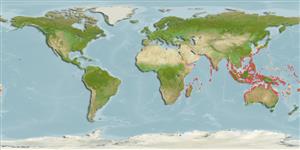Common names from other countries
>
Mugiliformes (Mullets) >
Mugilidae (Mullets)
Etymology: Crenimugil: Latin, crenulatus = cut, clipped + Latin, mugil = grey mullet (Ref. 45335).
More on author: Bleeker.
Environment: milieu / climate zone / depth range / distribution range
Écologie
marin; eau douce; saumâtre; catadrome (Ref. 46888); profondeur 0 - 10 m (Ref. 86942). Tropical; 39°N - 37°S, 22°E - 178°W
Indo-Pacific: from South Africa through parts of Indonesia to parts of Micronesia and Melanesia; north to the Mariana Islands and southern Japan (Ref. 9812).
Length at first maturity / Taille / Poids / Âge
Maturity: Lm 36.0 range ? - ? cm
Max length : 100.0 cm TL mâle / non sexé; (Ref. 4393); common length : 35.0 cm SL mâle / non sexé; (Ref. 4967)
Épines dorsales (Total): 5; Rayons mous dorsaux (Total): 8; Épines anales 3; Rayons mous anaux: 9.
Found in coastal waters, including estuaries and rivers (Ref. 5213). Young fish frequent estuaries and also ascend rivers and coastal creeks (Ref. 2847). It feeds on algae, diatoms, detritus, and crustaceans (Ref. 9812). Oviparous, eggs are pelagic and non-adhesive (Ref. 205). Caught during the spawning period (Ref. 9812). Other methods include the use of stakenets, pouch nets, and barrier nets (Ref. 9812).
Life cycle and mating behavior
Maturité | Reproduction | Frai | Œufs | Fécondité | Larves
Harrison, I.J. and H. Senou, 1997. Order Mugiliformes. Mugilidae. Mullets. p. 2069-2108. In K.E. Carpenter and V.H. Niem (eds.) FAO species identification guide for fishery purposes. The living marine resources of the Western Central Pacific. Volume 4. Bony fishes part 2 (Mugilidae to Carangidae). FAO, Rome. (Ref. 9812)
Statut dans la liste rouge de l'IUCN (Ref. 130435)
CITES (Ref. 128078)
Not Evaluated
Menace pour l'homme
Harmless
Utilisations par l'homme
Pêcheries: commercial
Plus d'informations
RéférencesAquacultureProfil d'aquacultureSouchesGénétiqueElectrophoresesHéritabilitéPathologiesTraitementMass conversion
Outils
Articles particuliers
Télécharger en XML
Sources Internet
Estimates based on models
Preferred temperature (Ref.
115969): 24.1 - 29, mean 28 (based on 1174 cells).
Phylogenetic diversity index (Ref.
82804): PD
50 = 0.5625 [Uniqueness, from 0.5 = low to 2.0 = high].
Bayesian length-weight: a=0.01349 (0.00893 - 0.02037), b=2.99 (2.87 - 3.11), in cm Total Length, based on LWR estimates for this species & (Sub)family-body (Ref.
93245).
Niveau trophique (Ref.
69278): 2.2 ±0.11 se; based on food items.
Résilience (Ref.
120179): Faible, temps minimum de doublement de population : 4,5 à 14 années (Preliminary K or Fecundity.).
Fishing Vulnerability (Ref.
59153): High vulnerability (60 of 100).
